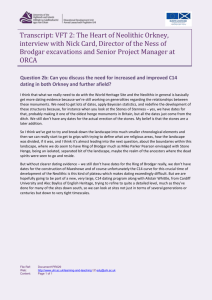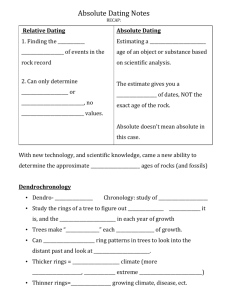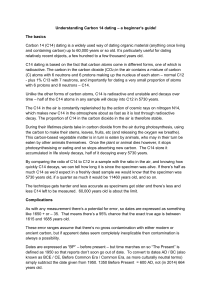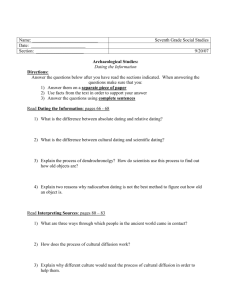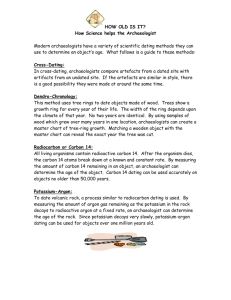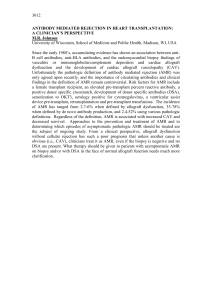Humanities Project
advertisement
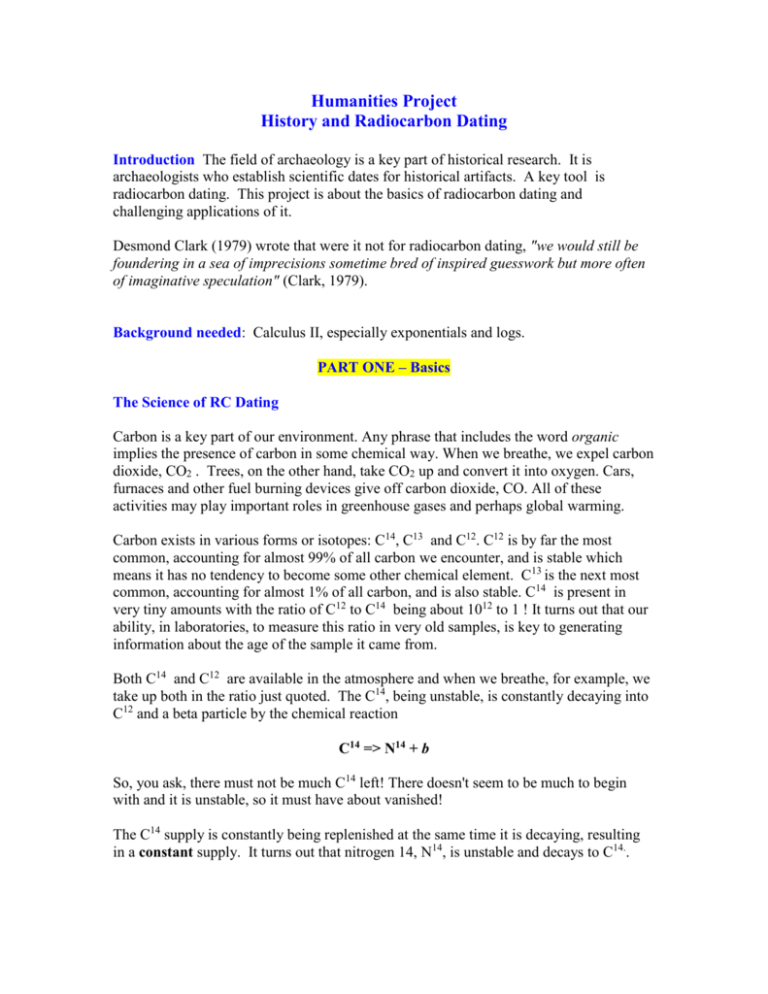
Humanities Project History and Radiocarbon Dating Introduction The field of archaeology is a key part of historical research. It is archaeologists who establish scientific dates for historical artifacts. A key tool is radiocarbon dating. This project is about the basics of radiocarbon dating and challenging applications of it. Desmond Clark (1979) wrote that were it not for radiocarbon dating, "we would still be foundering in a sea of imprecisions sometime bred of inspired guesswork but more often of imaginative speculation" (Clark, 1979). Background needed: Calculus II, especially exponentials and logs. PART ONE – Basics The Science of RC Dating Carbon is a key part of our environment. Any phrase that includes the word organic implies the presence of carbon in some chemical way. When we breathe, we expel carbon dioxide, CO2 . Trees, on the other hand, take CO2 up and convert it into oxygen. Cars, furnaces and other fuel burning devices give off carbon dioxide, CO. All of these activities may play important roles in greenhouse gases and perhaps global warming. Carbon exists in various forms or isotopes: C14, C13 and C12. C12 is by far the most common, accounting for almost 99% of all carbon we encounter, and is stable which means it has no tendency to become some other chemical element. C13 is the next most common, accounting for almost 1% of all carbon, and is also stable. C14 is present in very tiny amounts with the ratio of C12 to C14 being about 1012 to 1 ! It turns out that our ability, in laboratories, to measure this ratio in very old samples, is key to generating information about the age of the sample it came from. Both C14 and C12 are available in the atmosphere and when we breathe, for example, we take up both in the ratio just quoted. The C14, being unstable, is constantly decaying into C12 and a beta particle by the chemical reaction C14 => N14 + b So, you ask, there must not be much C14 left! There doesn't seem to be much to begin with and it is unstable, so it must have about vanished! The C14 supply is constantly being replenished at the same time it is decaying, resulting in a constant supply. It turns out that nitrogen 14, N14, is unstable and decays to C14.. So the ratio of C12 to C14 is constant in the atmosphere. This is important to remember. We and any living things are taking up both while we are alive so the ratio in us is also constant (about 1012:1 as mentioned earlier). Now the living object dies. At that moment, the intake of carbon (both kinds) ceases. The C14 which is already in it continues to deteriorate into C12 as always. So now the amount of C14 in the object begins to drop. It is the mathematics associated with this drop that allows people to figure out how old the object is! Historical comments The concept, method and technique of using the amount of Carbon 14 to date an object was developed around 1949 in Chicago by Professor Willad Libby of the University of Chicago. So remarkable was this work that he received the Nobel Prize in Chemistry in 1960! The reason that Libby's work attracted so much attention is this: it allowed archaeology to become a true science and cease being partially based on guesswork or circumstantial evidence. This point can not be underestimated! The Mathematics of Carbon Dating The material here follows that found in most calculus books. The shortcomings of calculus books is that they do not point out the significance of the work nor do they relate the mathematics to the overall Carbon cycle in any understandable way. The intent of this project is to address those shortcomings and expose the student to a really remarkable mix of history, technology and mathematics. We are developing a mathematical model here. This means that it has underlying assumptions and simplifications. Also once developed it must be tested which means it must provide correct dates for objects of known age. The work is more than merely pushing equations around! In what follows, let A = the amount of C14 in a previously living object at time t t = time in years A0 = the amount of C14 when the object died The fundamental assumption driving the model is this The rate of decay of the amount of C14 is proportional to how much is present at any time. This translates into a differential equation dA kA dT A(0) A0 The derivative, dA/dt, is the translation of the "rate of decay". The k is a proportionality constant to be determined. A is the amount at any time with A(0) being the original amount. For the moment our job is to solve this equation which means we want to find a function of t which is equal to A, and which satisfies the two conditions. Your calculus book works out the solution through the method of "separation of variables" and provides the solution as A(t) = A0ekt which is where we pick up. We still don't know what k is. What is known is that C14 has a half life of 5730 years (Libby originally estimated 5568 which was subsequently improved on). This means that however much one begins with for C14, after 5730 years you will have half as much. Mathematically this means that if we set t = 5730 then A must be set to A0/2 or A0/2 = A0 ek(5730) We can solve this for k with the algebra of natural logs. First we cancel A0: 1/2 = e5730k Next we take the natural log of both sides ln(1/2) = ln(e5730k) Next we use the fact that natural logs and exponentials are inverses so we now have ln(1/2) = 5730k as well as the property of logs that ln(1/2) = -ln(2) leaving us with k = - ln(2)/5730 or about -.00012 Which gives us a solution to the problem of A(t) = A0e-.00012t or A0e-(ln(2)/5730)t The graph of this is a decreasing exponential. It's value to us is that if we determine A(t) in a laboratory then we can substitute it in and divide by A0: A(t)/A0 = e-.00012t Since A0 is the value for a living organism it is known hence the ratio is known. We then solve the equation for t and thus know how old it is!! Using logs again we would have t = -(1/.00012)ln(A(t)/A0) or - 5730/2 ln(A(t)/A0) (Now you may be wondering about the – sign and if we are going to end up with negative time. The answer is no for the following reason: A(t) will be less than A0 due to decay. So the ratio A(t)/A0 will be less than 1 and its natural log will therefore be negative (take a look at the graph of natural log of x vs x in your text). The product of two negatives is a positive.) An interesting graph relating t and the ratio of A to A0 is Graph #1 (source: http://www.c14dating.com/int.html ) Where do you get A measured? Currently there are about 130 labs in the world that do radiocarbon dating. They use several different methods with the use of a Mass Spectrometer being a common one. A sample calculation Apply what has been shown to the following problem: suppose a sample of wood has been found to have 70% of the original level of C14. How old is it? Error Analysis It is possible that the half life of 5730 could be off by as much as 30 years. Assuming a worst case scenario, how much could that change your answer to the problem just prior to this? PART TWO – Challenging Problems In the 1950s, with the theory of radiocarbon dating presented, the next scientific step was for verification of it. This meant that very old samples, whose age was clearly known, had to be tested, with the hope that the RC method would provide approximately the same ages. Many of these test cases are included in the plot in Graph #1 earlier. Your job is to include a section in your paper where you have researched writings about the application of Bristlecone Pines from the western United States to radiocarbon calibration and verification. The Bristlecone Pines and other key examples gave the RC method the validity it needed to become an important historical tool. In 1988, a project came along to challenge it. This was prompted by the desire to establish the age of the Shroud of Turin. Please write a section on the general story of the Shroud of Turin. Your work should include the role of RC dating, the subsequent controversy, and attempts to reconcile the controversy. Conclusion You have seen a powerful mix of mathematics, technology and history. Your paper should represent your overall understanding of this mix. Specifically it should include Introduction Radio Carbon Dating Basics including 2 computational problems Bristlecone Pines and their Role The Shroud of Turin Conclusion References References Clark, J.D. 1979. Radiocarbon Dating and African Prehistory. In, Radiocarbon Dating. Proceedings of the Ninth International Conference, Los Angeles and La Jolla, 1976. R. Berger and H.E Suess (eds.). University of California Press, Los Angeles. Pp. 7-31. Libby, W.F. 1955. Radiocarbon Dating. University of Chicago Press, Chicago. Polach, H.A. 1976. Radiocarbon as a research tool in archaeology - hopes and limitations. In. Proceedings of the Symposium on Scientific Methods in the Study of Ancient Chinese Bronzes and Southeast Asian Metal and other Archaeological Artefacts. N. Barnard (ed.). National Gallery of Victoria, Melbourne, Australia. Pp. 255-98.
